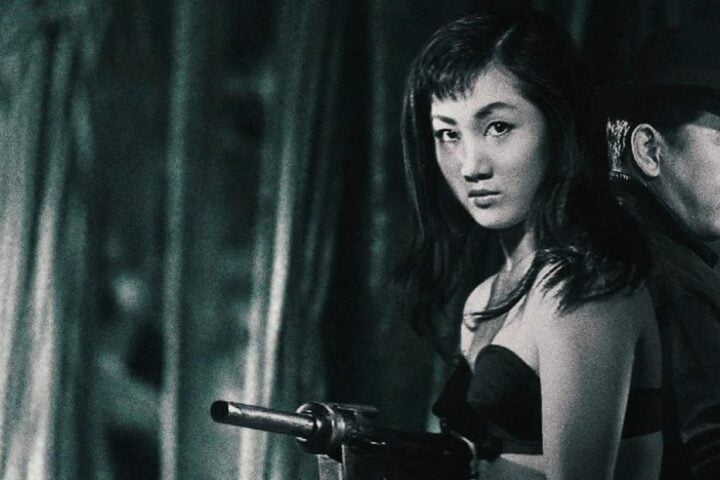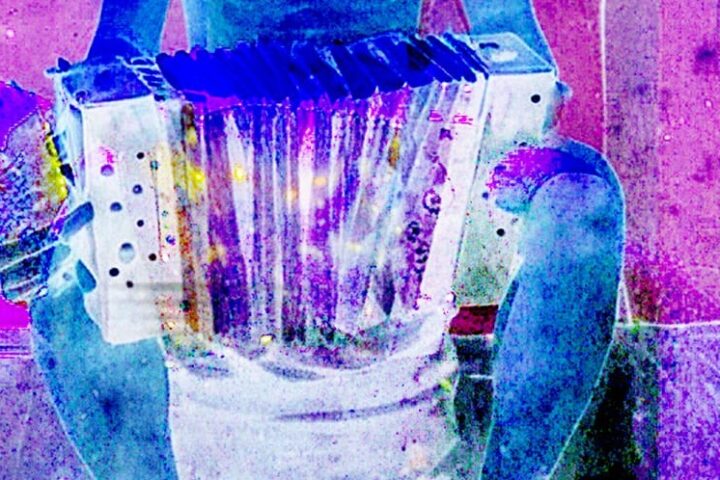Shinoda Masahiro’s Demon Pond unfolds at its own singular pace. The film’s ethereal, hypnagogic qualities are enhanced equally by the burnt orange and cerulean hues of Kosugi Masao and Sakamoto Noritaka’s painterly cinematography, which reflect its remote mountain village setting being stuck in a state of permanent evening twilight, and the constantly unpredictable ebbs and flows of electronic music pioneer Tomita Isao’s transfixingly restless Moog score. Where Tomita’s music includes modernized reworkings of pieces by 19th-century composers Claude Debussy and Modest Mussorgsky, Shinoda’s film fuses the kabuki theatricality of the 1913 play by Izumi Kyôka on which it was based with the uncanny artifice of then-groundbreaking, and still mind-bending, visual effects.
These collisions between the classical and the modern are fitting for a film that discomfitingly resides in various liminal states—between night and day, the otherworldly and the worldly, the artificial and the organic. Even Bandô Tamasaburô’s dual onnagata performances—as Yuri, the beautiful young wife of village bell-ringer Akira (Kato Go), and Princess Shirayuki, the dragon princess who lives at the bottom of the titular pond—are perfectly of a piece with the film’s vision of a world in a continual state of flux and unknowability.
On the level of plot, Demon Pond is also defined by a pervasive tension between the ancient and the modern, specifically superstition versus scientific reason. Yuri and Akira are the only people who believe that the tradition of ringing the town’s bell three times daily will prevent the dragon princess from rising from the depths of the pond and flooding the town. In the film’s first half, the mythic beings are primarily held at bay as the story focuses on the increasingly mysterious Yuri, a placid yet disquieting presence, as she fights to keep Akira from heading back to civilization with his old friend, the teacher and traveler Gakuen (Tsutomu Yamazaki), who randomly came across him on his journey throughout Japan.
While Akira’s presence adds to Demon Pond’s mystical atmosphere, it’s in the film’s second half that Shinoda fully amplifies the craziness, plunging into Princess Shirayuki’s whimsically creepy underworld to behold the various animistic spirits that dwell there alongside her. These hybrid human-animal creatures harken back to the animistic beliefs of Shintoism, while their theatrical make-up and overall presentation again connects Demon Pond to its kabuki roots.
These beings’ struggles to free themselves evoke notions of buried and forgotten Japanese beliefs and traditions, but the pleasures of Demon Pond lie less in its thematic resonance than in its strange, often surrealistic artistry. With its ever-shifting tone and vexing yet bewitching amalgam of historical and cultural influences, the film builds to an awe-inspiring conclusion—an apocalyptic vision that terrifies while also serving as a release valve for the tensions that have built up throughout the wonderfully bizarre fable that Shinoda so vividly illustrates.
Image/Sound
The Criterion Collection’s transfer of a new 4K digital restoration of Demon Pond shows minor signs of damage and debris in the first two reels, but it otherwise looks gorgeous. The film is set in a world of perpetual twilight time and the color grading here accurately reflects that stylistic choice, with burnt orange hues and earthy browns and reds standing in contrast to the vibrant greens. Details are rich and the contrast is consistently strong, allowing for full visibility of the entire frame even in the darkest of nighttime scenes. On the audio side, the uncompressed mono track is surprisingly robust, both in its presentation of the busier scenes with several dozen villagers and of composer Tomita Isao’s densely layered synth score.
Extras
In a new interview, film scholar Dudley Andrew discusses Izumi Kyōka’s original play on which the film was based before moving onto Shinoda Masahiro’s connection to theater and interest in fusing the aesthetics of theater and cinema. He also talks about Tomita’s unusual score and, most interestingly, draws compelling parallels between Shinoda’s career and that of Pier Paolo Pasolini. The other on-disc extra is a program on the film’s special effects with author Fabien Mauro, who gives a brief career overview of Japanese visual effects legend Yajima Nabuo before providing a fascinating and detailed breakdown of the man’s work on Demon Pond. Rounding out the package is a foldout booklet including an essay by critic Michael Atkinson, who expertly examines the film’s stylistic modes and unique blend of historical and modern influences.
Overall
Shinoda Masahiro’s sublime, phantasmagoric folk horror film feels all the more transportive thanks to a stunning new 4K transfer from the Criterion Collection.
Since 2001, we've brought you uncompromising, candid takes on the world of film, music, television, video games, theater, and more. Independently owned and operated publications like Slant have been hit hard in recent years, but we’re committed to keeping our content free and accessible—meaning no paywalls or fees.
If you like what we do, please consider subscribing to our Patreon or making a donation.



